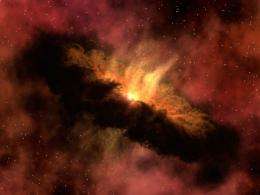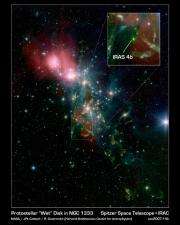Solar System Shield

Water vapor in planet-forming disks may block ultraviolet radiation from destroying water and other important molecules for life, according to new calculations.
The early solar system was tough on molecules. There were few places then to hide from the harsh ultraviolet radiation from the young Sun. However, new theoretical models show that water vapor provided a kind of shield - like the ozone layer in Earth's atmosphere - that protected molecules inside the planet-forming disk.
This water shield may have helped the disk hold onto water that later seeded the Earth's oceans. It could have also provided a safe haven for some of the biological building blocks known to form in space.
"Water is basically capable of sacrificing itself to protect the chemistry below it," says Ted Bergin of the University of Michigan in Ann Arbor.
Bergin and colleague Thomas Bethell calculated the survival rate of water vapor in the inner regions of young planetary systems. Somewhat unexpectedly, they found that several thousand oceans-worth of water can escape UV destruction.
The results, reported in a recent issue of the journal Science, may explain recent observations of water vapor around young stars, as well as help scientists trying to model how planets form.

Star light, star bright
When a star is born out of a dense cloud of dust and gas, some of the cloud material ends up in a flat disk circling the central star.
Initially, the gas in the cloud contains some simple molecules, but once the star "turns on" these molecules are at risk from the stellar radiation.
"Molecules are fragile," Bergin says. "The ultraviolet light can easily break them apart."
Ultraviolet photons striking the molecule H2O, for example, will strip off one hydrogen and then the other, leaving a single oxygen atom.
Water and other molecules are provided some protection by dust in the disk. But as the grains grow bigger on their way to forming planets, they no longer block UV radiation.
The general consensus was that there should be a limited number of molecules around million-year-old stars when grains have grown, and yet recent observations have detected large quantities of water and OH vapor floating in the inner disk regions of several such stars.
To explain these observations, some scientists suggested that comets from cold outer regions fly in towards their host star, releasing frozen water through evaporation. However, this hypothesis doesn't seem to account for the OH data in the disk, Bergin says.
Sun screen for the solar system
Bergin had a hunch that the water vapor in the inner disk was dense enough that it could chemically reassemble itself just as fast as the UV was destroying it. He and Bethell ran models for various star luminosities and disk temperatures and found that in most cases a thin layer of water surrounding the disk could absorb the incoming radiation.
"What Bethell and Bergin have showed is that if water is present, it can protect itself from destruction as the water begins to reform on quick timescales, preventing the light from destroying all of it," says Fred Ciesla of the University of Chicago.
The authors predict that the amount of "space mist" surrounding a young star should be equivalent to many thousands of oceans. They show that this is consistent with three previous water detections in planet-forming disks.
The water shield not only protects other water molecules, but it also would keep radiation from destroying other molecules in the inner disk region.
"Water in the disk provides this nice umbrella," Bergin says.
Under this umbrella, organic chemistry could operate, perhaps leading to some of the biological building blocks that have been detected in very old meteorites and the innermost regions near young stars.

Follow the water
One nagging question is what happens to all the oceans of water in the inner disk as the star gets older and its planets grow up. Bergin believes the water vapor within about 1 AU (the Earth-Sun distance) eventually gets destroyed. "Over time, radiation will win," he says.
But out at 3 AU (where our solar system's asteroid belt is located) the lower temperature may have allowed water vapor to condense onto the solid material forming in the disk. As it so happens, astronomers have recently detected icy asteroids that have comet-like compositions but appear to originate from inside the asteroid belt.
There has been some speculation that icy asteroids may have delivered water to the early Earth. The idea stems from the fact that our planet's oceans have a high ratio of deuterium to hydrogen, signifying that the water formed in a colder part of space than where Earth formed.
This could mean that some of the water vapor from the early days of our inner solar system wound up in our drinking supply.
Ciesla is somewhat skeptical. He thinks the situation that the authors are considering occurred too late in the evolution of the solar system to explain Earth's water. By the time the water-shielding mechanism becomes important, the solid material would have developed into clumps of rock, resulting in less overall surface area onto which water could condense.
However, Ciesla does believe these new results will help scientists peel away some of the uncertainty about the planet formation supposedly going on inside the thick dusty disks around young stars.
Source: Astrobio.net

















